Impact of Digital and AI Manufacturing on Society and Firms
VerifiedAdded on 2023/06/07
|7
|2318
|155
AI Summary
This article analyzes the impact of digital and AI manufacturing on society and firms. It discusses the research methods used and presents arguments/findings from various articles. The observation is that digital and AI manufacturing are transforming the industrial world and propelling global industrialization into the latest phase of technological development.
Contribute Materials
Your contribution can guide someone’s learning journey. Share your
documents today.
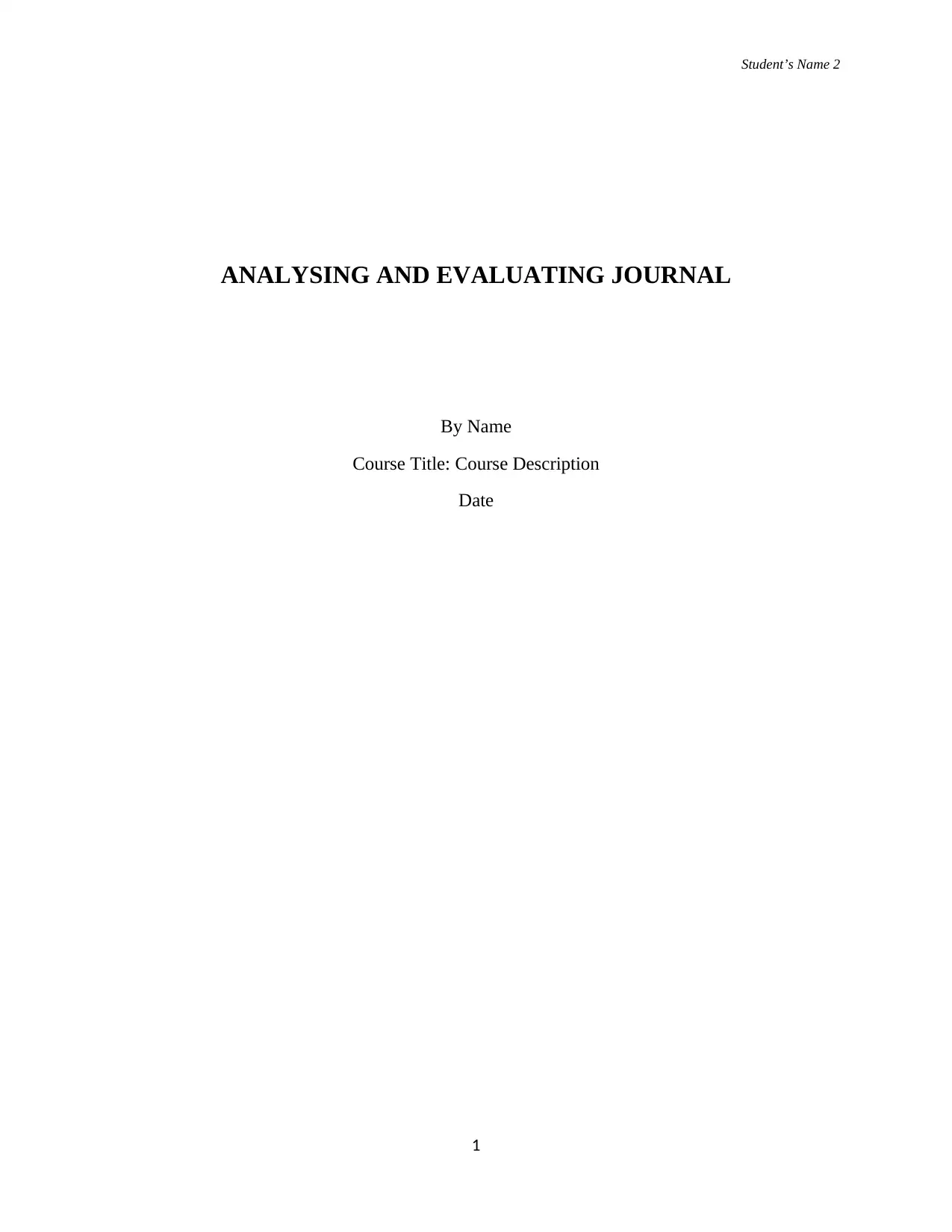
Student’s Name 2
ANALYSING AND EVALUATING JOURNAL
By Name
Course Title: Course Description
Date
1
ANALYSING AND EVALUATING JOURNAL
By Name
Course Title: Course Description
Date
1
Secure Best Marks with AI Grader
Need help grading? Try our AI Grader for instant feedback on your assignments.

Student’s Name 2
1. Identify and discuss the research method(s) which is used
throughout this article.
Articles Research Method Definition
Article 1
Makridakris, Sypros. “The
Forthcoming Artificial
Intelligence (AI) Revolution:
It’s Impact on Society and
Firms.” Elsevier, Volume 90
(2013): 46-60.
Qualitative Research
Qualitative Research is a
research method that collects,
analyses and interprets data by
observing the field of research.
Article 2 Pan, Yunhe. “Heading
toward Artificial Intelligence
2.0,” Elsevier, Volume 4, no.
2 (2016): 409:413.
Non-participant
observation
Non-participant
observation is a research
method where the
researcher is not part of the
group in study but studies
the behaviour of the group
Article 3
Hartmann, Brian., King, William P.
and Narayanan, Subu.
“Digital Manufacturing: The
Revolution will be
Vairtualized.” Mckinsey &
Company. (2016).
https://www.mckinsey.com/b
usiness-functions/operations/
our-insights/digital-
manufacturing-the-
revolution-will-be-
virtualized. (Accessed
September 19, 2018).
Qualitative Research
Qualitative Research is a
research method that
collects, analyses and
interprets data by
observing the field of
research.
2. Argument / Finding
Article 1 Arguments / Findings
Makridakis agrees that digital inventions have been substantial in all aspects of our lives
including firms, living, employment and society.1 Considering the analogue, digital and in
particular AI inventions, Makridakis concludes that the latter will have a far more reaching effect
than the first two.
1 Sypros Makridakris, “The Forthcoming Artificial Intelligence (AI) Revolution: It’s Impact on Society and Firms,”
Elsevier, Volume 90 (2013): 46-60.
2
1. Identify and discuss the research method(s) which is used
throughout this article.
Articles Research Method Definition
Article 1
Makridakris, Sypros. “The
Forthcoming Artificial
Intelligence (AI) Revolution:
It’s Impact on Society and
Firms.” Elsevier, Volume 90
(2013): 46-60.
Qualitative Research
Qualitative Research is a
research method that collects,
analyses and interprets data by
observing the field of research.
Article 2 Pan, Yunhe. “Heading
toward Artificial Intelligence
2.0,” Elsevier, Volume 4, no.
2 (2016): 409:413.
Non-participant
observation
Non-participant
observation is a research
method where the
researcher is not part of the
group in study but studies
the behaviour of the group
Article 3
Hartmann, Brian., King, William P.
and Narayanan, Subu.
“Digital Manufacturing: The
Revolution will be
Vairtualized.” Mckinsey &
Company. (2016).
https://www.mckinsey.com/b
usiness-functions/operations/
our-insights/digital-
manufacturing-the-
revolution-will-be-
virtualized. (Accessed
September 19, 2018).
Qualitative Research
Qualitative Research is a
research method that
collects, analyses and
interprets data by
observing the field of
research.
2. Argument / Finding
Article 1 Arguments / Findings
Makridakis agrees that digital inventions have been substantial in all aspects of our lives
including firms, living, employment and society.1 Considering the analogue, digital and in
particular AI inventions, Makridakis concludes that the latter will have a far more reaching effect
than the first two.
1 Sypros Makridakris, “The Forthcoming Artificial Intelligence (AI) Revolution: It’s Impact on Society and Firms,”
Elsevier, Volume 90 (2013): 46-60.
2

Student’s Name 2
Article 2 Arguments / Findings
In support of AI technology, Pan says in recent years, a significant number of
multinational companies have expressed great interests in artificial intelligence. Thus, AI
manufacturing has rapidly expanded in schools, homes and the corporate world. Majority of
industries are interested in the many benefits of AI. For example, beginning in the year 2011 to
date, companies such as Google, Apple, Twitter, Intel and Microsoft have purchased on average
140 firms using the AI systems.2 Research also reveals that the total investment of AI in 2015
for about 200 AI related organizations totals 1.5 billion dollars.
Article 3 Arguments / Findings
Hartmann and his friends agrees that digital revolution will positively change the nature
of manufacturing. Hartmann goes on to say that digital manufacturing will transform all areas of
manufacturing from customer engagement, research and development, processing, supply chain,
and service.3 According to Hartmann, digital revolution in the manufacturing sector motivates
organizations to link physical assets by a “digital thread” in the next decade.
In an attempt to illustrate why companies need to adopt the new style of manufacturing,
Hartmann gives an example by comparing the old car manufactures and Uber. Old car
manufactures, and Uber are both involved in the business public transport. Old car manufacturers
meet the transportation needs of people by moving into factory floors, showrooms and other
designated areas. However, Uber meets the transportation needs of people by matching riders’
preference for vehicles using digital devices such as a Smartphone. Unlike five years ago, today
Uber’s revenue has seen enormous growth and is listed as one of the most successful car
manufacturers.
3. Evidence (How do this author’s views compare with what
others have said on the same or similar topic)
Article 1
Articles selected
1. Yunhe Pan, “Heading toward Artificial Intelligence 2.0.”
2. Stuart Russell and Peter Norvig. “Artificial Intelligence.”
Section One
Sharing similar sentiments with Makridakis, Pan supports that AI systems have led to
tremendous positive changes in firms.4 For example, the Watson system begun by IBM is
beneficial in hospitals for screening numerous patient accounts for records of cancer cure to give
proposals for diagnosing and therapeutic counsel. Microsoft in 2016 acquired the LinkedIn and
purposed to use AI knowledge to restructure the corporate social community. In addition,
Microsoft invested in Xiaobing, which is a chatting robot able to interpret graphics into an
interrelation with human language and expressive perceptive. Therefore, if companies want to
pace up with the technological advancements and maintain their competitive edge, they have to
2 Elsevier, Volume 4, no. 2 (2016): 409:413.
3 Brian Hartmann, William P. King, and Subu Narayanan, “Digital Manufacturing: The Revolution will be
Virtualized,” Mckinsey & Company, (2016), https://www.mckinsey.com/business-functions/operations/our-
insights/digital-manufacturing-the-revolution-will-be-virtualized, (Accessed September 19, 2018).
4 Yunhe Pan, “Heading toward Artificial Intelligence 2.0,” Elsevier, Volume 4, no. 2 (2016): 409:413
3
Article 2 Arguments / Findings
In support of AI technology, Pan says in recent years, a significant number of
multinational companies have expressed great interests in artificial intelligence. Thus, AI
manufacturing has rapidly expanded in schools, homes and the corporate world. Majority of
industries are interested in the many benefits of AI. For example, beginning in the year 2011 to
date, companies such as Google, Apple, Twitter, Intel and Microsoft have purchased on average
140 firms using the AI systems.2 Research also reveals that the total investment of AI in 2015
for about 200 AI related organizations totals 1.5 billion dollars.
Article 3 Arguments / Findings
Hartmann and his friends agrees that digital revolution will positively change the nature
of manufacturing. Hartmann goes on to say that digital manufacturing will transform all areas of
manufacturing from customer engagement, research and development, processing, supply chain,
and service.3 According to Hartmann, digital revolution in the manufacturing sector motivates
organizations to link physical assets by a “digital thread” in the next decade.
In an attempt to illustrate why companies need to adopt the new style of manufacturing,
Hartmann gives an example by comparing the old car manufactures and Uber. Old car
manufactures, and Uber are both involved in the business public transport. Old car manufacturers
meet the transportation needs of people by moving into factory floors, showrooms and other
designated areas. However, Uber meets the transportation needs of people by matching riders’
preference for vehicles using digital devices such as a Smartphone. Unlike five years ago, today
Uber’s revenue has seen enormous growth and is listed as one of the most successful car
manufacturers.
3. Evidence (How do this author’s views compare with what
others have said on the same or similar topic)
Article 1
Articles selected
1. Yunhe Pan, “Heading toward Artificial Intelligence 2.0.”
2. Stuart Russell and Peter Norvig. “Artificial Intelligence.”
Section One
Sharing similar sentiments with Makridakis, Pan supports that AI systems have led to
tremendous positive changes in firms.4 For example, the Watson system begun by IBM is
beneficial in hospitals for screening numerous patient accounts for records of cancer cure to give
proposals for diagnosing and therapeutic counsel. Microsoft in 2016 acquired the LinkedIn and
purposed to use AI knowledge to restructure the corporate social community. In addition,
Microsoft invested in Xiaobing, which is a chatting robot able to interpret graphics into an
interrelation with human language and expressive perceptive. Therefore, if companies want to
pace up with the technological advancements and maintain their competitive edge, they have to
2 Elsevier, Volume 4, no. 2 (2016): 409:413.
3 Brian Hartmann, William P. King, and Subu Narayanan, “Digital Manufacturing: The Revolution will be
Virtualized,” Mckinsey & Company, (2016), https://www.mckinsey.com/business-functions/operations/our-
insights/digital-manufacturing-the-revolution-will-be-virtualized, (Accessed September 19, 2018).
4 Yunhe Pan, “Heading toward Artificial Intelligence 2.0,” Elsevier, Volume 4, no. 2 (2016): 409:413
3
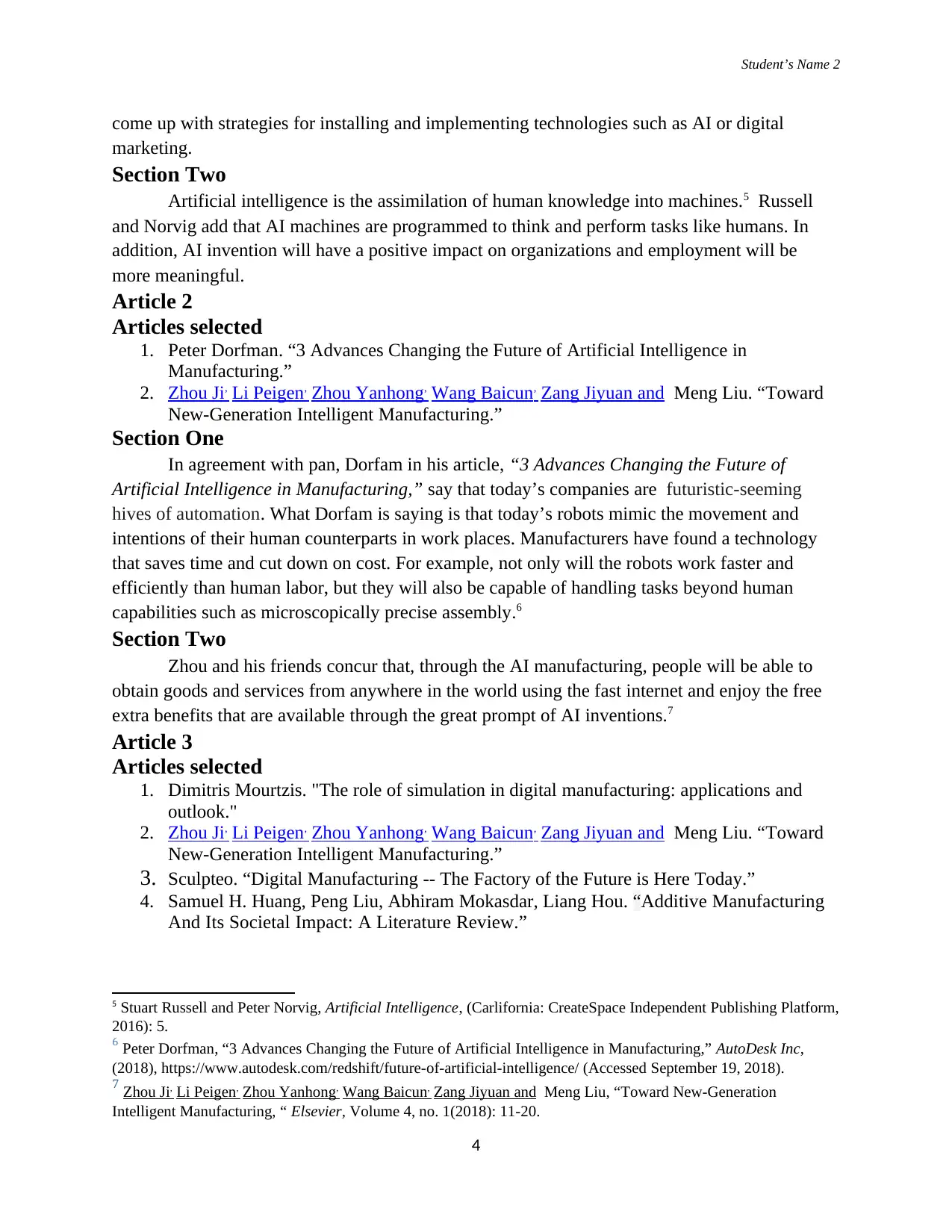
Student’s Name 2
come up with strategies for installing and implementing technologies such as AI or digital
marketing.
Section Two
Artificial intelligence is the assimilation of human knowledge into machines.5 Russell
and Norvig add that AI machines are programmed to think and perform tasks like humans. In
addition, AI invention will have a positive impact on organizations and employment will be
more meaningful.
Article 2
Articles selected
1. Peter Dorfman. “3 Advances Changing the Future of Artificial Intelligence in
Manufacturing.”
2. Zhou Ji, Li Peigen, Zhou Yanhong, Wang Baicun, Zang Jiyuan and Meng Liu. “Toward
New-Generation Intelligent Manufacturing.”
Section One
In agreement with pan, Dorfam in his article, “3 Advances Changing the Future of
Artificial Intelligence in Manufacturing,” say that today’s companies are futuristic-seeming
hives of automation. What Dorfam is saying is that today’s robots mimic the movement and
intentions of their human counterparts in work places. Manufacturers have found a technology
that saves time and cut down on cost. For example, not only will the robots work faster and
efficiently than human labor, but they will also be capable of handling tasks beyond human
capabilities such as microscopically precise assembly.6
Section Two
Zhou and his friends concur that, through the AI manufacturing, people will be able to
obtain goods and services from anywhere in the world using the fast internet and enjoy the free
extra benefits that are available through the great prompt of AI inventions.7
Article 3
Articles selected
1. Dimitris Mourtzis. "The role of simulation in digital manufacturing: applications and
outlook."
2. Zhou Ji, Li Peigen, Zhou Yanhong, Wang Baicun, Zang Jiyuan and Meng Liu. “Toward
New-Generation Intelligent Manufacturing.”
3. Sculpteo. “Digital Manufacturing -- The Factory of the Future is Here Today.”
4. Samuel H. Huang, Peng Liu, Abhiram Mokasdar, Liang Hou. “Additive Manufacturing
And Its Societal Impact: A Literature Review.”
5 Stuart Russell and Peter Norvig, Artificial Intelligence, (Carlifornia: CreateSpace Independent Publishing Platform,
2016): 5.
6 Peter Dorfman, “3 Advances Changing the Future of Artificial Intelligence in Manufacturing,” AutoDesk Inc,
(2018), https://www.autodesk.com/redshift/future-of-artificial-intelligence/ (Accessed September 19, 2018).
7 Zhou Ji, Li Peigen, Zhou Yanhong, Wang Baicun, Zang Jiyuan and Meng Liu, “Toward New-Generation
Intelligent Manufacturing, “ Elsevier, Volume 4, no. 1(2018): 11-20.
4
come up with strategies for installing and implementing technologies such as AI or digital
marketing.
Section Two
Artificial intelligence is the assimilation of human knowledge into machines.5 Russell
and Norvig add that AI machines are programmed to think and perform tasks like humans. In
addition, AI invention will have a positive impact on organizations and employment will be
more meaningful.
Article 2
Articles selected
1. Peter Dorfman. “3 Advances Changing the Future of Artificial Intelligence in
Manufacturing.”
2. Zhou Ji, Li Peigen, Zhou Yanhong, Wang Baicun, Zang Jiyuan and Meng Liu. “Toward
New-Generation Intelligent Manufacturing.”
Section One
In agreement with pan, Dorfam in his article, “3 Advances Changing the Future of
Artificial Intelligence in Manufacturing,” say that today’s companies are futuristic-seeming
hives of automation. What Dorfam is saying is that today’s robots mimic the movement and
intentions of their human counterparts in work places. Manufacturers have found a technology
that saves time and cut down on cost. For example, not only will the robots work faster and
efficiently than human labor, but they will also be capable of handling tasks beyond human
capabilities such as microscopically precise assembly.6
Section Two
Zhou and his friends concur that, through the AI manufacturing, people will be able to
obtain goods and services from anywhere in the world using the fast internet and enjoy the free
extra benefits that are available through the great prompt of AI inventions.7
Article 3
Articles selected
1. Dimitris Mourtzis. "The role of simulation in digital manufacturing: applications and
outlook."
2. Zhou Ji, Li Peigen, Zhou Yanhong, Wang Baicun, Zang Jiyuan and Meng Liu. “Toward
New-Generation Intelligent Manufacturing.”
3. Sculpteo. “Digital Manufacturing -- The Factory of the Future is Here Today.”
4. Samuel H. Huang, Peng Liu, Abhiram Mokasdar, Liang Hou. “Additive Manufacturing
And Its Societal Impact: A Literature Review.”
5 Stuart Russell and Peter Norvig, Artificial Intelligence, (Carlifornia: CreateSpace Independent Publishing Platform,
2016): 5.
6 Peter Dorfman, “3 Advances Changing the Future of Artificial Intelligence in Manufacturing,” AutoDesk Inc,
(2018), https://www.autodesk.com/redshift/future-of-artificial-intelligence/ (Accessed September 19, 2018).
7 Zhou Ji, Li Peigen, Zhou Yanhong, Wang Baicun, Zang Jiyuan and Meng Liu, “Toward New-Generation
Intelligent Manufacturing, “ Elsevier, Volume 4, no. 1(2018): 11-20.
4
Secure Best Marks with AI Grader
Need help grading? Try our AI Grader for instant feedback on your assignments.
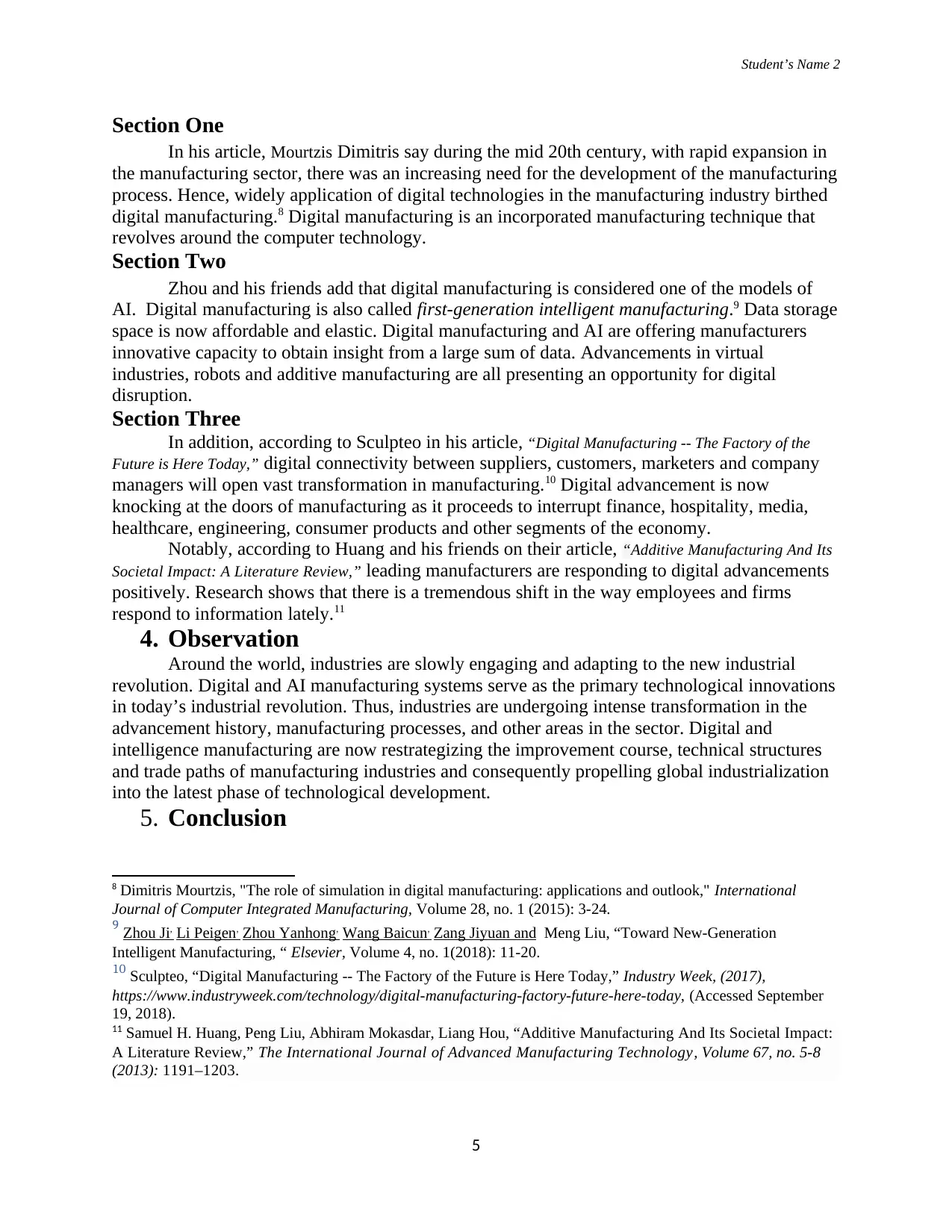
Student’s Name 2
Section One
In his article, Mourtzis Dimitris say during the mid 20th century, with rapid expansion in
the manufacturing sector, there was an increasing need for the development of the manufacturing
process. Hence, widely application of digital technologies in the manufacturing industry birthed
digital manufacturing.8 Digital manufacturing is an incorporated manufacturing technique that
revolves around the computer technology.
Section Two
Zhou and his friends add that digital manufacturing is considered one of the models of
AI. Digital manufacturing is also called first-generation intelligent manufacturing.9 Data storage
space is now affordable and elastic. Digital manufacturing and AI are offering manufacturers
innovative capacity to obtain insight from a large sum of data. Advancements in virtual
industries, robots and additive manufacturing are all presenting an opportunity for digital
disruption.
Section Three
In addition, according to Sculpteo in his article, “Digital Manufacturing -- The Factory of the
Future is Here Today,” digital connectivity between suppliers, customers, marketers and company
managers will open vast transformation in manufacturing.10 Digital advancement is now
knocking at the doors of manufacturing as it proceeds to interrupt finance, hospitality, media,
healthcare, engineering, consumer products and other segments of the economy.
Notably, according to Huang and his friends on their article, “Additive Manufacturing And Its
Societal Impact: A Literature Review,” leading manufacturers are responding to digital advancements
positively. Research shows that there is a tremendous shift in the way employees and firms
respond to information lately.11
4. Observation
Around the world, industries are slowly engaging and adapting to the new industrial
revolution. Digital and AI manufacturing systems serve as the primary technological innovations
in today’s industrial revolution. Thus, industries are undergoing intense transformation in the
advancement history, manufacturing processes, and other areas in the sector. Digital and
intelligence manufacturing are now restrategizing the improvement course, technical structures
and trade paths of manufacturing industries and consequently propelling global industrialization
into the latest phase of technological development.
5. Conclusion
8 Dimitris Mourtzis, "The role of simulation in digital manufacturing: applications and outlook," International
Journal of Computer Integrated Manufacturing, Volume 28, no. 1 (2015): 3-24.
9 Zhou Ji, Li Peigen, Zhou Yanhong, Wang Baicun, Zang Jiyuan and Meng Liu, “Toward New-Generation
Intelligent Manufacturing, “ Elsevier, Volume 4, no. 1(2018): 11-20.
10 Sculpteo, “Digital Manufacturing -- The Factory of the Future is Here Today,” Industry Week, (2017),
https://www.industryweek.com/technology/digital-manufacturing-factory-future-here-today, (Accessed September
19, 2018).
11 Samuel H. Huang, Peng Liu, Abhiram Mokasdar, Liang Hou, “Additive Manufacturing And Its Societal Impact:
A Literature Review,” The International Journal of Advanced Manufacturing Technology, Volume 67, no. 5-8
(2013): 1191–1203.
5
Section One
In his article, Mourtzis Dimitris say during the mid 20th century, with rapid expansion in
the manufacturing sector, there was an increasing need for the development of the manufacturing
process. Hence, widely application of digital technologies in the manufacturing industry birthed
digital manufacturing.8 Digital manufacturing is an incorporated manufacturing technique that
revolves around the computer technology.
Section Two
Zhou and his friends add that digital manufacturing is considered one of the models of
AI. Digital manufacturing is also called first-generation intelligent manufacturing.9 Data storage
space is now affordable and elastic. Digital manufacturing and AI are offering manufacturers
innovative capacity to obtain insight from a large sum of data. Advancements in virtual
industries, robots and additive manufacturing are all presenting an opportunity for digital
disruption.
Section Three
In addition, according to Sculpteo in his article, “Digital Manufacturing -- The Factory of the
Future is Here Today,” digital connectivity between suppliers, customers, marketers and company
managers will open vast transformation in manufacturing.10 Digital advancement is now
knocking at the doors of manufacturing as it proceeds to interrupt finance, hospitality, media,
healthcare, engineering, consumer products and other segments of the economy.
Notably, according to Huang and his friends on their article, “Additive Manufacturing And Its
Societal Impact: A Literature Review,” leading manufacturers are responding to digital advancements
positively. Research shows that there is a tremendous shift in the way employees and firms
respond to information lately.11
4. Observation
Around the world, industries are slowly engaging and adapting to the new industrial
revolution. Digital and AI manufacturing systems serve as the primary technological innovations
in today’s industrial revolution. Thus, industries are undergoing intense transformation in the
advancement history, manufacturing processes, and other areas in the sector. Digital and
intelligence manufacturing are now restrategizing the improvement course, technical structures
and trade paths of manufacturing industries and consequently propelling global industrialization
into the latest phase of technological development.
5. Conclusion
8 Dimitris Mourtzis, "The role of simulation in digital manufacturing: applications and outlook," International
Journal of Computer Integrated Manufacturing, Volume 28, no. 1 (2015): 3-24.
9 Zhou Ji, Li Peigen, Zhou Yanhong, Wang Baicun, Zang Jiyuan and Meng Liu, “Toward New-Generation
Intelligent Manufacturing, “ Elsevier, Volume 4, no. 1(2018): 11-20.
10 Sculpteo, “Digital Manufacturing -- The Factory of the Future is Here Today,” Industry Week, (2017),
https://www.industryweek.com/technology/digital-manufacturing-factory-future-here-today, (Accessed September
19, 2018).
11 Samuel H. Huang, Peng Liu, Abhiram Mokasdar, Liang Hou, “Additive Manufacturing And Its Societal Impact:
A Literature Review,” The International Journal of Advanced Manufacturing Technology, Volume 67, no. 5-8
(2013): 1191–1203.
5
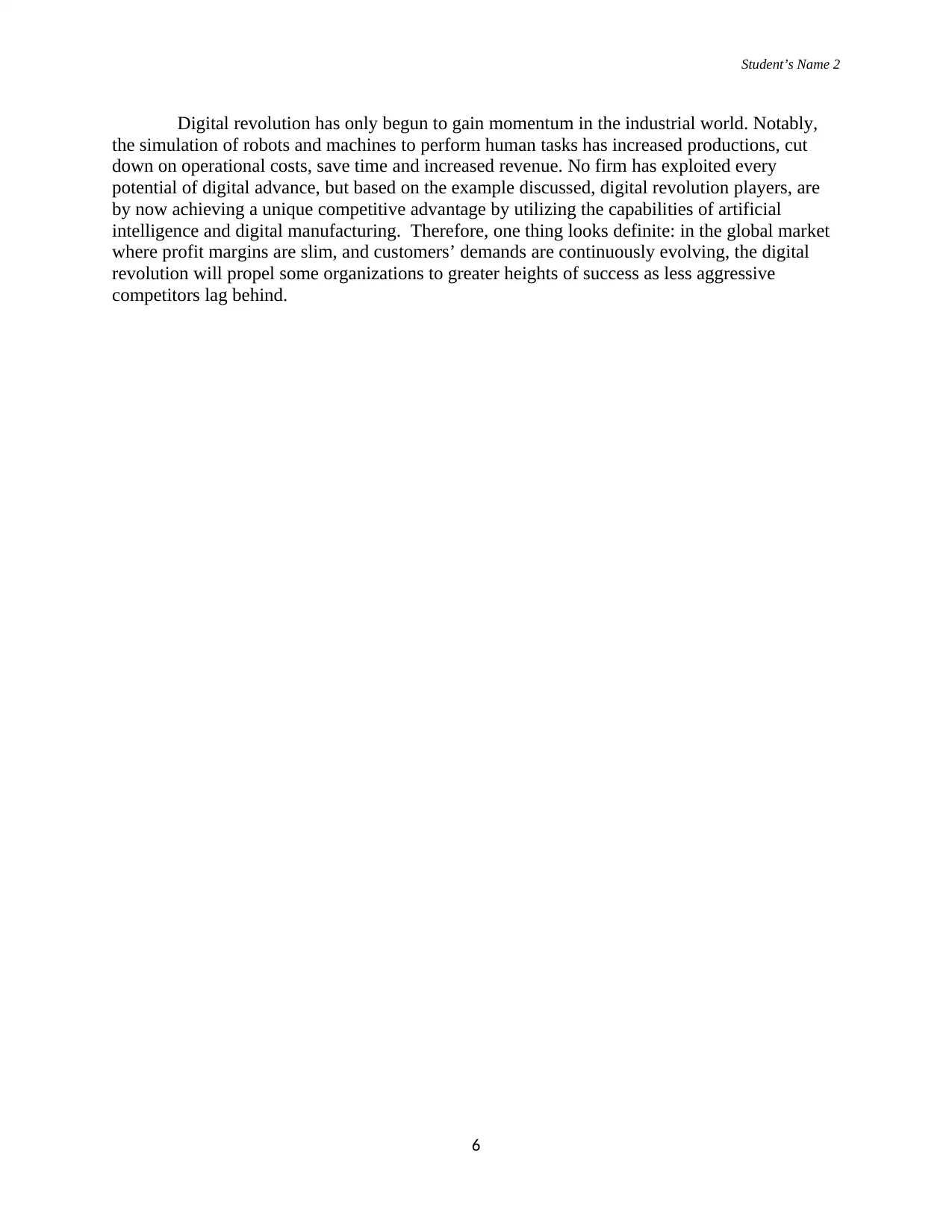
Student’s Name 2
Digital revolution has only begun to gain momentum in the industrial world. Notably,
the simulation of robots and machines to perform human tasks has increased productions, cut
down on operational costs, save time and increased revenue. No firm has exploited every
potential of digital advance, but based on the example discussed, digital revolution players, are
by now achieving a unique competitive advantage by utilizing the capabilities of artificial
intelligence and digital manufacturing. Therefore, one thing looks definite: in the global market
where profit margins are slim, and customers’ demands are continuously evolving, the digital
revolution will propel some organizations to greater heights of success as less aggressive
competitors lag behind.
6
Digital revolution has only begun to gain momentum in the industrial world. Notably,
the simulation of robots and machines to perform human tasks has increased productions, cut
down on operational costs, save time and increased revenue. No firm has exploited every
potential of digital advance, but based on the example discussed, digital revolution players, are
by now achieving a unique competitive advantage by utilizing the capabilities of artificial
intelligence and digital manufacturing. Therefore, one thing looks definite: in the global market
where profit margins are slim, and customers’ demands are continuously evolving, the digital
revolution will propel some organizations to greater heights of success as less aggressive
competitors lag behind.
6
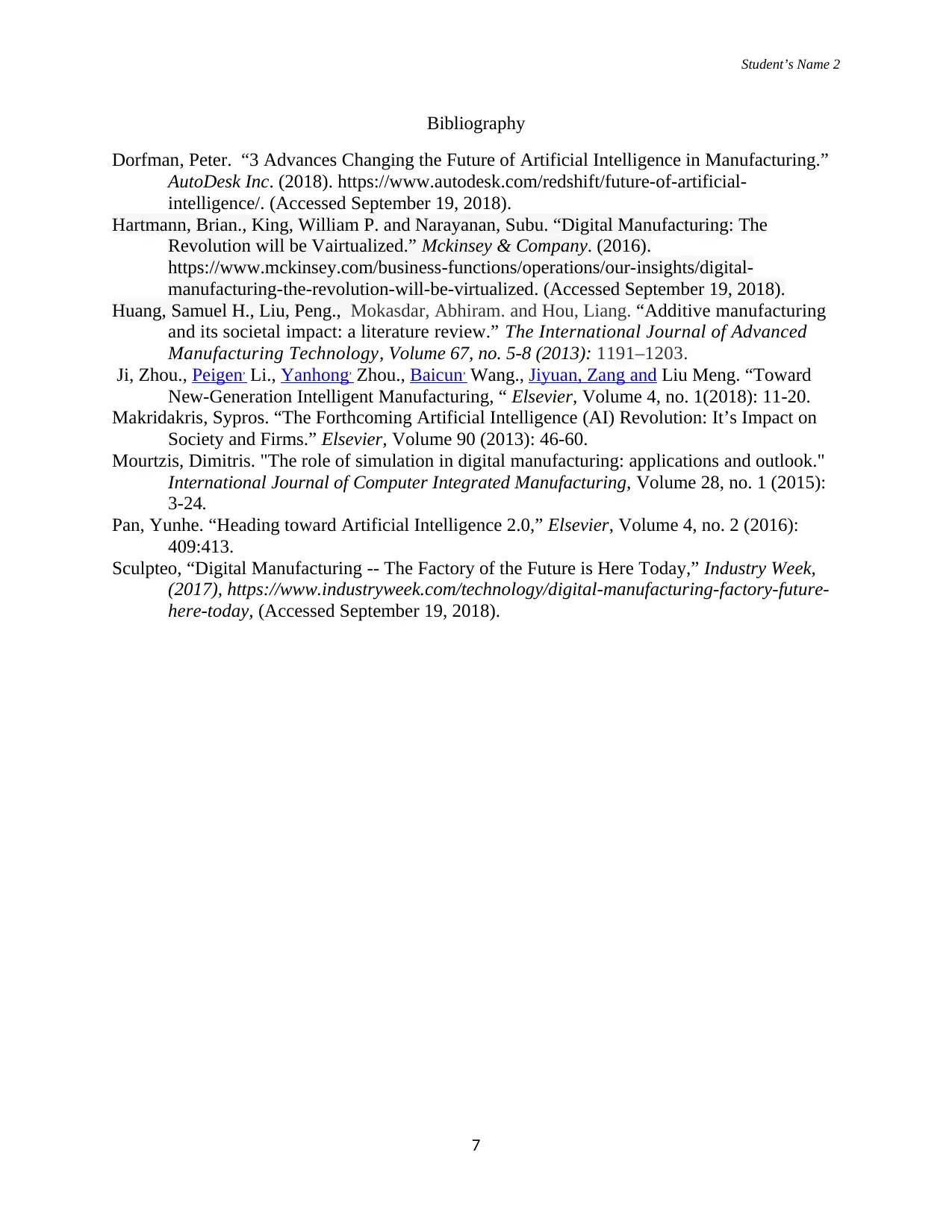
Student’s Name 2
Bibliography
Dorfman, Peter. “3 Advances Changing the Future of Artificial Intelligence in Manufacturing.”
AutoDesk Inc. (2018). https://www.autodesk.com/redshift/future-of-artificial-
intelligence/. (Accessed September 19, 2018).
Hartmann, Brian., King, William P. and Narayanan, Subu. “Digital Manufacturing: The
Revolution will be Vairtualized.” Mckinsey & Company. (2016).
https://www.mckinsey.com/business-functions/operations/our-insights/digital-
manufacturing-the-revolution-will-be-virtualized. (Accessed September 19, 2018).
Huang, Samuel H., Liu, Peng., Mokasdar, Abhiram. and Hou, Liang. “Additive manufacturing
and its societal impact: a literature review.” The International Journal of Advanced
Manufacturing Technology, Volume 67, no. 5-8 (2013): 1191–1203.
Ji, Zhou., Peigen, Li., Yanhong, Zhou., Baicun, Wang., Jiyuan, Zang and Liu Meng. “Toward
New-Generation Intelligent Manufacturing, “ Elsevier, Volume 4, no. 1(2018): 11-20.
Makridakris, Sypros. “The Forthcoming Artificial Intelligence (AI) Revolution: It’s Impact on
Society and Firms.” Elsevier, Volume 90 (2013): 46-60.
Mourtzis, Dimitris. "The role of simulation in digital manufacturing: applications and outlook."
International Journal of Computer Integrated Manufacturing, Volume 28, no. 1 (2015):
3-24.
Pan, Yunhe. “Heading toward Artificial Intelligence 2.0,” Elsevier, Volume 4, no. 2 (2016):
409:413.
Sculpteo, “Digital Manufacturing -- The Factory of the Future is Here Today,” Industry Week,
(2017), https://www.industryweek.com/technology/digital-manufacturing-factory-future-
here-today, (Accessed September 19, 2018).
7
Bibliography
Dorfman, Peter. “3 Advances Changing the Future of Artificial Intelligence in Manufacturing.”
AutoDesk Inc. (2018). https://www.autodesk.com/redshift/future-of-artificial-
intelligence/. (Accessed September 19, 2018).
Hartmann, Brian., King, William P. and Narayanan, Subu. “Digital Manufacturing: The
Revolution will be Vairtualized.” Mckinsey & Company. (2016).
https://www.mckinsey.com/business-functions/operations/our-insights/digital-
manufacturing-the-revolution-will-be-virtualized. (Accessed September 19, 2018).
Huang, Samuel H., Liu, Peng., Mokasdar, Abhiram. and Hou, Liang. “Additive manufacturing
and its societal impact: a literature review.” The International Journal of Advanced
Manufacturing Technology, Volume 67, no. 5-8 (2013): 1191–1203.
Ji, Zhou., Peigen, Li., Yanhong, Zhou., Baicun, Wang., Jiyuan, Zang and Liu Meng. “Toward
New-Generation Intelligent Manufacturing, “ Elsevier, Volume 4, no. 1(2018): 11-20.
Makridakris, Sypros. “The Forthcoming Artificial Intelligence (AI) Revolution: It’s Impact on
Society and Firms.” Elsevier, Volume 90 (2013): 46-60.
Mourtzis, Dimitris. "The role of simulation in digital manufacturing: applications and outlook."
International Journal of Computer Integrated Manufacturing, Volume 28, no. 1 (2015):
3-24.
Pan, Yunhe. “Heading toward Artificial Intelligence 2.0,” Elsevier, Volume 4, no. 2 (2016):
409:413.
Sculpteo, “Digital Manufacturing -- The Factory of the Future is Here Today,” Industry Week,
(2017), https://www.industryweek.com/technology/digital-manufacturing-factory-future-
here-today, (Accessed September 19, 2018).
7
1 out of 7
Related Documents
Your All-in-One AI-Powered Toolkit for Academic Success.
+13062052269
info@desklib.com
Available 24*7 on WhatsApp / Email
![[object Object]](/_next/static/media/star-bottom.7253800d.svg)
Unlock your academic potential
© 2024 | Zucol Services PVT LTD | All rights reserved.
